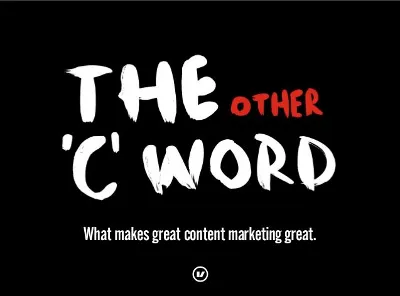
So, Doug, you started off (in part one) by saying that so much content is created these days that it’s hard to stand out. Have you got a view on what’s coming next? Are we just going to get more and more inundated or will somebody find a way to cut through this or filter it to get to the stuff we’re interested in?
I feel that very soon content marketing is going to become a “home run” game. I know that’s an American metaphor but what I mean is it will be about the big hits, the pieces that actually move markets as opposed to the background stuff that keeps you in the game. I think people are going to start learning that a few of those in any programme changes everything, changes the dynamics of everything. It can make even a mediocre strategy look utterly brilliant if you just get a few winners in there. So people hopefully will be aiming higher.
Part of that, I believe, will be that we will start to tap into emotion, even in B2B marketing. I think making people think something is a wonderful thing, but making them feel something is magic. It’s much harder to do. But aiming for that emotion is important, and we’re going to see even B2B marketing start to dig down for things that matter. That’s where emotion lives and passion lives and beliefs live.
I also think we’re still kind of in the age of Gutenberg. Everyone’s still thinking about print and the print paradigm. So white papers have given way to e-books, but it’s still words on a page that gets flipped. I do think that more dynamic screen experiences and mobile devices and tablets are going to start taking over. So rather than something that’s really ported over from the print world and stuck on a screen, there will be native screen experiences.
In the consumer world, you see a lot of these scrolling sites with this wonderful parallax scroll thing going on. We’re having fun with that with some B2B clients now, too. That’s just one example of how we can get away from Gutenberg and get onto what these new devices are really good at? That feels like another big trend in content marketing.
I guess that’s about the interaction as well, though, isn’t it Doug? People with one or more screens in front of them are able to react in the moment to the content that they’re experiencing.
Yes, definitely. I think it’s a function of the age of the marketers. That is, as the digital natives start coming up, they’re going to be naturally creating digital experiences that feel right for the moment, as opposed to the shoving people down a print route.
I want to talk about the B2B Marketing Manifesto you wrote awhile back. What you highlight in there rings so true, specifically the three reasons why the B2B Marketer is the engine of the company. Can you tell us what those three reasons are?
The main thing about the manifesto was a plea for ambition among B2B marketers. At the time – and I guess it’s still true – B2B marketers weren’t very ambitious, weren’t very confident. They didn’t have a lot of power in their company, and that really came from their performance over the years. Their stock had gone down in the company, so this was a call to “rise up”; that’s why we called it a manifesto.
One of the reasons we felt that marketers should be the most important person in the company is that they own the pipeline. The way things are going with lead nurturing and demand generation, marketers really do control that pipeline. Sales people are going to close the deals, but if there’s nothing in the pipeline, the best sales team in the world isn’t going to do very well.
The second reason was that they own the information; that marketers are naturally masters of information. Information is, if not a bigger and bigger part of the product, sometimes the whole product. If we’re great at information, we should also have this incredibly important role in the company and content marketing is a great example of that.
And thirdly, marketers should own innovation. Marketers are perfectly placed to be the innovation drivers in companies. I feel marketers are in a unique position when it comes to innovation, because sales guys are meeting with customers every day and so they tend to get the demands of the existing customer in existing customer terms.
There’s a great book by Clayton Christensen called The Innovator’s Dilemma that talks all about this. How when you’re too close to your customers you can be trapped in some old world thinking. Marketers are a step back from that. We see all sorts of things out there in the market. I think we should be bringing those things back to businesses and saying, “I know there’s a product you told me to go sell, but what if we had this? Look what we could do.”
So for me, those three things: owning the pipeline; owning information; and having a great line on innovation. Those three things coming together in a modern B2B marketing role say, “Wow, this is a person who really should be on CEO track and should be hugely powerful in the company.”
I think it’s exactly right. Marketers have an enormous opportunity right now to affect the way the company works, not just the marketing, not just the messaging, but the whole company and its success.
Some sales people probably have a great ability to lift above things and see perhaps more than their own customers. But I do find that really, really good sales people are so empathetic and attuned to their customers that it’s hard for them to go that next level above – almost that helicopter view - saying, “I know you’re passionate about this need in your business right now, Mr Customer, but look what’s coming.”
.jpg?width=400&name=Manifesto_cover%20(1).jpg) The example Clay Christensen uses in his book is to do with little hard drives. The next answer to the little hard drive was always an even littler hard drive, and so on. Then flash memory came along and, baboom, took the whole thing over and blindsided everybody. Because sales guys and companies were serving their customers so well they missed some fairly disruptive innovations. He makes a great case, using a lot of real data about how infrequently disruptive innovation comes from market leaders and people who are incumbent in a market.
The example Clay Christensen uses in his book is to do with little hard drives. The next answer to the little hard drive was always an even littler hard drive, and so on. Then flash memory came along and, baboom, took the whole thing over and blindsided everybody. Because sales guys and companies were serving their customers so well they missed some fairly disruptive innovations. He makes a great case, using a lot of real data about how infrequently disruptive innovation comes from market leaders and people who are incumbent in a market.
And I do think marketers have that extra benefit of swimming out there in the wider market, rather than slavishly serving the customer every day.
That idea of marketing owning innovation gets us into the realms of social CRM and social business where we are able to use the social spaces to gather a lot more data than we’ve ever been able to. And are able to listen to conversations and understand what the wider marketplace is talking about to try to turn that back into our product development process.
Absolutely. When I was saying earlier about how I started with thinking of social media as a vector for our content only, what I’ve come to understand is what an amazing listening post it is. Even if you had duct taped your mouth shut and put your keyboard in the drawer, you’d still learn so much from what’s happening on social.
Any company that’s asking, “Where do I start?” it would really be there; just go in there and listen a lot. Soon you’ll be really moved to participate. But just the listening alone is quite an amazing thing.
Yes, we’re getting an awful lot of people saying to us that they’re not sure that social is the right place for traditional marketing, anyway. That there needs to be a very, very different approach to it.
I really think so, too. Like so many new things, it takes a while to figure that out. With almost every innovation that came along, we’ve played with it and then slowly bed down with it. Little by little, light bulbs go off and you realise, “Aha, this is a new medium. This isn’t just a new spin on everything that’s come before. New rules apply.”
I do think you’re right, social media and traditional marketing don’t really go together. I know it’s kind of a facile truism now that one-way, broadcast marketing doesn’t work and is old school. But when you really start experiencing what a community is like and the power of a community, the penny drops and you realise this is a whole new ballgame.
Doug, you’re latest piece is a sort of follow up to Crap. Can we talk about that?
It’s called The Other C Word. I’m starting to evangelise another magic ingredient in all of this. I feel like that ingredient is confidence. Confidence marketing is inherently attractive.
Obviously the confidence has to be tempered with empathy and authenticity and authority in a field. But if you’ve got those things anyway, which you should have, just coming out with real confident content is a big differentiator. Because so much content is not confident. It is magnetic to just come out and show that you really believe what you are doing. People lean forward for confident people, and the same goes for confident content.
So my latest soapbox is all about confidence. Again, it sounds like a bit of a woolly idea, but we use it in our day to day work at Velocity with clients to help make decisions about things. We ask, “Is that the confident way to go or is that the safe way, the covering-your-ass kind of way to go?” So this is a new front for me, talking about confidence.
Are you talking about being bolshie or loud or disruptive?
It doesn’t have to be that at all. I think a lot of people feel, “Oh, confidence means that. I’ll get out there and shout and get in people’s faces.” Sometimes that is good; I like a good rant.
But, really, if you’ve got the passion, use it and go for it. Faking that is horrible. It’s like your dad dancing or pretending you’re angry when you’re not. You get these columnists or bloggers who just love controversy and you know when they’re only trying to court it. That’s not what I’m talking about. Confidence could be quite quiet.
There’s a GE Aviation film called Paths of Flight, which has no narration at all. There are no special effects, except that they shoot a whole bunch of planes taking off and landing and put them all in the same frame, like a time shift thing. It’s a thing of beauty. I think it took real confidence for them to say, “This tells its own story.” So there’s an example of wonderful confidence that isn’t in your face or brash or bolshie or any of those things.
So I’m glad you asked that because I do think a lot of people associate the word with loud. For me it just means absolutely believing what you’re saying and having the confidence to relax, say less, say exactly what you mean, say it in a human way.
----------------
This is part two of the transcript of episode 37 of The Social Media Show, featuring Doug Kessler of Velocity Partners. If you missed it, part one is here.




